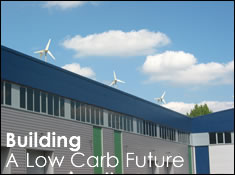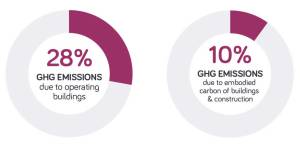- Renewable Energy
- Posted
Building a low carb future

The need to reduce CO2 emissions and energy consumption from buildings has never been more immediate. There is a growing consensus that we must reduce our dependence on rapidly depleting, carbon intensive fossil fuels, which, amongst other things, will involve overhauling how buildings are designed, constructed and used. Achieving this involves a combination of everything from introducing innovative policy, to enforcement of building regulations, to adapting to more advanced construction methods and technologies, as Gavin Killip, Senior Researcher at Oxford University’s Environmental Change Institute describes
These are interesting times for anyone with an interest in bringing low-carbon buildings into the mainstream. We have new, tighter building regulations to think about; new methods of compliance to grapple with; voluntary codes to consider; and several local authorities ‘doing a Fingal’ – demanding even tougher standards as a condition of planning.
Where will all this activity actually get us? Will it deliver genuinely low-carbon new buildings? Or is the current flurry of interest simply muddying the waters of regulation, giving designers and developers additional bureaucracy to deal with but not delivering any significant increase in actual building performance?
Building regulations are non-prescriptive on design – and rightly so. This gives designers and developers the freedom to choose materials and create solutions that are specific to the building brief, sympathetic to the site and local area, within a given budget, and subject to the scrutiny of the planning authority. The Building Regulations are blind to architecture and urban design: they just dictate a standard.
As climate change moves up the political agenda, design standards under the 2006 Part L are expressed in terms of CO2 emissions as well as energy. Using carbon dioxide as a metric does focus minds on the real problem we’re trying to address, and it also allows for even greater flexibility for designers in finding solutions. But several big problems remain: firstly, there is widespread non-compliance with building regulations. A recent study for the UK’s Energy Saving Trust surveyed building control officers in England and Wales and found that hardly any of them deemed energy to be an important enough issue to enforce. Only if a building was deficient in terms of structure or fire safety would building control officers take legal action. An earlier survey of 99 new homes in the UK found that about two-thirds were compliant on the new air-tightness test. The truth on the ground is that the building codes are not being met: the claimed gains in efficiency from new regulations are almost certainly over-stated.
Secondly, the design standards used in calculating compliance do not translate into actual performance in real life. The design standards assume a perfect world where no mistakes are made on construction sites, no corners are cut, no product substitution takes place, and hard-to-measure factors such as thermal bridging are effectively ignored. Various studies have also shown that the energy performance of essentially identical dwellings can be very varied, according to the behaviour of the building occupants and their ability to understand and control the energy systems provided for them. As thermal fabric performance increases and energy for space heating reduces as a proportion of the total, so the relative proportion increases for hot water, lighting and appliances. Electricity demand for lights and appliances is rising fast: constraining the growth to manageable proportions will require stricter minimum standards for product design at an EU level. There has already been a good deal of success with minimum standards supported by the familiar A – G energy labels on fridges and other appliances. This market transformation approach needs to be continued and tightened. Wider international initiatives have the potential to reduce demand even further. One would be to mandate an upper limit on standby power consumption for all electrical and electronic appliances (such as the 1 Watt Initiative). Worldwide, only 25% of electrical energy is well managed at the level of circuit-boards and power transformers – the other 75% represents US $400,000,000,000 of wasted electricity every year.
One of the unintended consequences of setting targets in terms of CO2 emissions is the opening up of new loopholes that quick-witted developers, with an eye on profitability and speed of compliance, are seeking to exploit. The root cause of these loopholes is the concept of trade-offs – allowing a reduced performance in one aspect of building design in exchange for compliance beyond the minimum elsewhere.
Trade-offs were allowed in the 1990s when elemental U values were still the preferred metric of compliance. The thermal performance was deemed to be a function of thermal performance and total area, which led to a flurry of homes being built with small windows and lower levels of insulation in the walls. The thinking behind this was that, as windows are generally less insulating than walls, the performance of the whole structure would be improved if the area of wall was increased and the area of glazing decreased. Then the thermal performance of the walls need not be so tight for the entire envelope to achieve the same thermal properties. With the gift of hindsight we know that the resulting designs provide poor levels of daylight (adding to electric lighting loads) and a legacy of sub-optimal wall constructions that would be very costly and disruptive to improve. This is one of the down-sides to having regulations that are blind to design.
The equivalent to Fingal in the UK is Merton Borough Council in London. In 2003 they pioneered a planning policy that required 10% of energy be generated from on-site renewables in developments over a certain size. It takes courage for a local authority to be innovative in this way but, once the national government had retrospectively endorsed the policy in its revised Planning Policy Statement 22 (PPS 22), published in 2004, there was a rush among other forward-thinking local authorities to follow Merton’s lead. Instead of getting their fingers burned or their wrists slapped, Merton Council was rewarded with a level of fame that it had never had before. It seems to be part of the culture in large public sector organisations that, when it comes to doing something pioneering, everybody wants to be second.
In the game of catch-up that followed, there are now several dozen local authorities in England with similar policies to Merton’s. Some require 10% on only the largest developments; some ask for slightly higher percentages; some apply the rule to all developments, including the very smallest; some have stated publicly their intention to make the requirement more stringent over time: for example, Kirklees in West Yorkshire wants 30% by 2011 and the GLA has set a ramp to reach 30% across London by 2025.

Benoit Lebot, developer of the 1 Watt Initiative
In the rush to join in, and in a probably unavoidable spirit of one-upmanship between different councils, there is a danger that developers end up faced with a different set of building codes in each area.
The pace of change is being pushed forward by local government action, but the plethora of individual initiatives will surely reach a point where some consolidation is required. Perhaps, following the example of PPS 22, the UK government will retrospectively apply its stamp of approval and draw up a national consensus document in the process. Or maybe the government will simply decide to use the existing national consensus document – part L of the Building Regulations?
Anomalies and loopholes are already appearing in the gaps between local and national policy development.
A ‘server farm’ is a building full of servers (computers) providing IT capability to thousands of users outside the building. This is a class of development that will seriously challenge on-site renewable energy policies. With electrical loads of several megawatts in one modest-sized building, how realistic or sensible is it to demand that 10% (let alone 30%) be generated on-site? The size of PV array required could easily be larger than the building itself. Or, if wind were the preferred option, the technically logical answer would be one or more large turbines. However, these work best away from the low-speed, turbulent air-flows that predominate around buildings. This tension between energy-intensive facilities like server farms and the diffuse nature of all renewable energy sources will need to be resolved. We may need to agree that certain classes of buildings providing energy-intensive services are exempted or treated differently.
In the process of building new buildings, developers deal first with the planning regime and only address building regulations later on. The requirement to achieve a percentage of on-site renewable energy supply has led some developers to complain that this effectively rules out the possibility of applying for ‘outline’ planning approval, as the detailed work needed to show how much renewable energy will be generated is the same as doing a full planning application. This may be a change of practice that is unavoidable. In terms of loopholes, planning officers also need to keep an eye open for potential double-counting. If a developer has incorporated on-site renewable energy sources to meet the 10% planning requirement, how is that reflected in their calculations to show compliance with part L? Given that the metric for part L is now carbon dioxide emissions (rather than U values), there is scope for developers to argue for looser standards on insulation or airtightness in a building which has renewable energy technology built in. Adrian Hewitt, Senior Planning Officer for Merton Borough Council, is clear that these trade-offs should not be allowed, and that his council’s requirement is additional to the requirement to comply with part L. Clear guidance for planning officers will be needed and, in most cases, additional training will be needed to provide the skills for the technical assessments. This is particularly challenging against the background of generally low morale among planners, increasing workloads and poor recruitment and retention in the profession.
In another twist to the unfolding Fingal/Merton story, some developers have begun to look beyond their own development, arguing that they can achieve more for climate change by retro-fitting insulation in existing homes nearby, rather than adding expensive, unfamiliar renewable energy technology to their own scheme. Insulating a few dozen lofts down the road is cheaper and a lot less hassle for the developer than really getting to grips with low CO2 emissions from their own development. This argument makes sense in the context of a single development, but not in the wider context of national or regional CO2 reduction targets. We need to reduce CO2 emissions from both new and existing buildings: doing only one is not enough. Resources and policies need to be found to upgrade the existing stock, but not at the expense of improved quality in new-build. Allowing a developer to trade off the impact of their own development by picking off the cheap, quick improvements in a housing estate down the road will only serve to continue the legacy of under-performing new buildings.
Much of the detail of ‘doing a Fingal’ will emerge over the coming months and years as all parties in the planning process become more familiar with it. For climate change policy, it is crucial that superficially plausible trade-offs are resisted. The UK Association for Environment-Conscious Building, among others, has argued cogently that the thermal performance of new floors and walls is particularly important to get right, as retro-fit improvements are both costly and disruptive. A U-value in the range 0.1 – 0.15 W/m2K for floors and walls is about what is needed for genuinely low CO2 emissions in our northern temperate climate. Achieving comfort in hotter summers without recourse to carbon-intensive air-conditioning is a design challenge that can be met using appropriate thermal mass and control of solar gain through shading devices.

A 'server farm' is a building full of servers providing IT capability to thousands of users outside the building. This is a class of development that will seriously challenge on-site renewable energy policies
This new design brief is beyond the conventional 100mm masonry cavity wall and the construction industry has successfully fought against such standards for that very reason: genuinely low-emissions buildings require new methods, new products and a shake-up in the whole supply chain. The training and skills agenda is similarly large and all-encompassing: old methods will not be good enough for new building work, so an entire industry will have to renew its skills over quite a short time. This is not a comfortable thought for established players in the industry, and many have chosen so far to ignore it or argue against the need for it. However, forward-thinking business leaders need to come to grips with the supply-chain and skills issues. The role of government should be to set out the broad goal of genuinely low-emissions from new-build over a manageable timescale – say over the next ten years – and send a consistent policy message to industry stakeholders with the implicit ultimatum: adapt or die. Government – both national and local – can also play an important role in this rapid evolution of the construction industry by demanding future standards on publicly funded projects in advance of those standards coming into force through regulation. Publicly funded projects would become test-beds for innovation and learning.
The quickest innovators would be doubly rewarded - by gaining the contracts and by being early entrants into a transformed market-place. Maybe the next step for pioneering councils on both sides of the Irish Sea is to impose a two-tier system of planning requirements, with tougher standards for publicly-funded projects and a non-litigious contractual structure (so-called partnering contracts) that fosters innovation, collaboration and learning. A combination of a pioneering local authority and a pioneering development team could begin to bring these inter-dependent issues together.
In a carbon-constrained future economy, there will be a much greater need for accurate monitoring and reporting on energy and carbon dioxide emissions. For buildings, this will involve a move towards measuring and managing actual energy consumption, not just imposing design standards as we do now. The new building energy label (under the EU Energy Performance of Buildings Directive) can provide a platform for a lot of additional work, making the link between buildings’ energy consumption and climate change both explicit and visible. Ultimately, the industry will need to move towards providing guarantees to building occupiers: Energy Performance Certificates. The problems of boundaries between building fabric (designer’s/developer’s responsibility) and plug loads (occupier’s responsibility) need to be worked out, but that is largely a question of sub-metering. The interactions between the two (for example, additional computers add to incidental heat gains, which in turn add to air-conditioning load) will need to be addressed through a much better process of commissioning. Building designers need to understand better how users really use buildings, and users need a commitment from designers to engage with the reality of how buildings get used.
Only when all these disparate strands come together – energy labels on buildings; energy performance certificates; monitoring, metering and reporting; training for new skills; new supply chains; publicly funded test-beds for innovation – will the potential of the new planning rules be fully realised.
- Articles
- renewable energy
- Building a Low Carb Future
- emissions
- carbon
- fossil fuels
- killip
- wind
- solar
- server farm
- policy
- fingal
- energy performance
Related items
-
 Much ado about nothing
Much ado about nothing -
Ireland joins whole life carbon data initiative
-
WorldGBC launches green building policy principles for governments
-
 Decarbonising buildings “most important issue” – Climate Change Committee
Decarbonising buildings “most important issue” – Climate Change Committee -
 Techrete aims for net zero carbon by 2030
Techrete aims for net zero carbon by 2030 -
 Grant invests in biofuel tech for oil boilers
Grant invests in biofuel tech for oil boilers -
 Oil heating sector pivots to biofuels, but green groups raise concern
Oil heating sector pivots to biofuels, but green groups raise concern -
 Architects call for urgent climate action ahead of COP 26
Architects call for urgent climate action ahead of COP 26 -
 Campaign launched to tackle whole-life environmental impact of buildings
Campaign launched to tackle whole-life environmental impact of buildings -
 Towards greener homes — the role of green finance
Towards greener homes — the role of green finance -
 SEAI Energy Awards 2020 open for entries
SEAI Energy Awards 2020 open for entries -
 The first oil crisis
The first oil crisis

